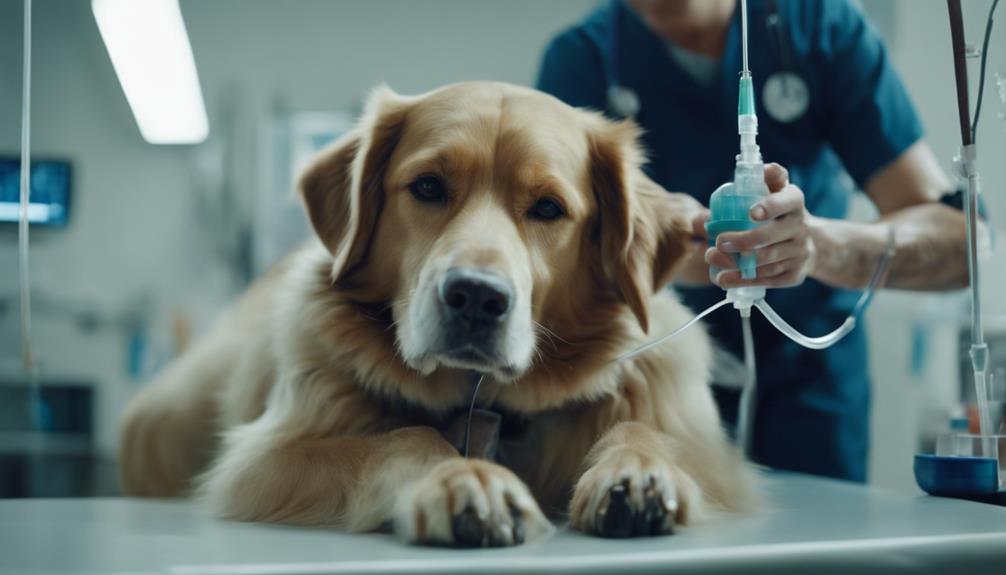Recognition of potential warning signs for cancer in dogs is a vital aspect of responsible pet ownership.
From subtle alterations in behavior to more overt physical symptoms, early detection plays a crucial role in the successful management of canine malignancies.
By understanding the red flags associated with various types of cancer, pet owners can take proactive steps to safeguard their furry companions' health.
Stay tuned to unravel the nuanced indicators that may signal a deeper health concern in your beloved canine friend.
Key Takeaways
- Watch for subtle signs like lumps and lameness.
- Different cancers present with various symptoms.
- Early detection through regular checks is crucial.
- Treatment and prognosis vary based on cancer type.
Subtle and Nonspecific Early Signs
Characterized by their subtlety and nonspecific nature, early signs of cancer in dogs can often go unnoticed without careful observation and comparison of body parts for abnormalities. Owners should be vigilant for any unexplained changes in their dog's behavior, appetite, weight, or energy levels.
Additionally, persistent gastrointestinal issues such as vomiting, diarrhea, or difficulty eating could signal an underlying problem. Any unexplained lumps, bumps, or swelling on the body should be promptly evaluated by a veterinarian, as these can sometimes be early indicators of cancer.
Keep an eye out for signs like lameness, difficulty breathing, or sudden changes in your dog's physical appearance. Early detection plays a crucial role in successful cancer treatment outcomes for dogs.
Comparison for Abnormalities
Early signs of cancer in dogs can often be overlooked, but one crucial step in detecting potential abnormalities is through regular comparison of body parts for any unusual changes. By routinely examining your dog's skin, coat, eyes, ears, mouth, and limbs, you can identify any new growths, changes in size or color, lesions, or swelling that may indicate a problem.
Pay attention to any changes in your dog's behavior or habits as well, as these can sometimes be early indicators of an underlying issue. Regular comparison for abnormalities can help catch potential signs of cancer early, leading to prompt veterinary attention and potentially improving the prognosis for your beloved pet.
Regular Lumps and Bumps Check

When conducting regular checks for lumps and bumps on your dog, it is essential to be thorough and systematic in your approach. Start by running your hands over your dog's body, feeling for any unusual growths or swellings.
Pay close attention to areas where lumps are more commonly found, such as the neck, armpits, and groin. Look for any changes in size, shape, or texture of existing lumps, as well as any new growths that may have appeared.
If you notice anything concerning, it is important to consult your veterinarian promptly for further evaluation. Early detection of lumps and bumps can lead to timely diagnosis and treatment, potentially improving outcomes for your furry companion.
Gastrointestinal Issue Indicators
A dog's gastrointestinal issues can manifest through various subtle signs that pet owners should be vigilant in observing. These signs may include changes in appetite, vomiting, or diarrhea. It is essential to monitor your dog's digestive habits regularly to detect any abnormalities that could indicate an underlying health concern. If you notice persistent gastrointestinal problems, consulting with a veterinarian is crucial to rule out potential issues such as cancer.
Gastrointestinal Issue Indicators:
- Changes in Appetite: Keep an eye on your dog's eating habits; a sudden decrease or increase in appetite could signal a problem.
- Vomiting: Occasional vomiting is normal, but frequent or persistent vomiting should be evaluated by a professional.
- Diarrhea: Loose stools or frequent bowel movements may indicate gastrointestinal distress that warrants attention.
Heart and Lung Problem Signs

Signs of heart and lung problems in dogs can manifest through distinct behavioral changes and physical symptoms that warrant prompt attention from pet owners. Watch out for increased respiratory rate or effort, coughing, wheezing, fainting, weakness, and exercise intolerance in your canine companion.
Additionally, bluish gums, excessive panting, and a reluctance to lie down may indicate underlying heart or lung issues. Changes in appetite, weight loss, and reduced stamina can also be linked to these problems.
If you notice any of these signs, it is crucial to seek veterinary advice promptly to determine the underlying cause and initiate appropriate treatment. Early detection and intervention can significantly improve the prognosis for dogs with heart and lung problems.
Concerning Lameness and Growth
Concerning lameness and growth in dogs can be indicative of underlying health issues that necessitate timely veterinary evaluation and intervention. When observing these signs in your furry companion, it's crucial to be proactive and seek professional guidance.
Here are three important points to consider:
- Persistent Lameness: If your dog shows consistent limping, favoring a particular leg, or reluctance to bear weight, it could signal musculoskeletal problems or even bone cancer.
- Unexplained Rapid Growth: Sudden and unexplained growth spurts in certain areas of your dog's body, such as abnormal swelling or enlargement, should raise concern and warrant a veterinarian's assessment.
- Changes in Mobility: Noticeable changes in your dog's mobility, such as stiffness, difficulty getting up, or reluctance to engage in physical activities, may indicate underlying issues that require prompt attention.
Common Cancer Types in Dogs

Among the prevalent ailments affecting dogs, cancer manifests in various forms and poses a significant health concern for our canine companions. Common types of cancer in dogs include hemangiosarcoma, lymphoma, melanoma, mast cell tumors, osteosarcoma, and mammary cancer.
Hemangiosarcoma impacts blood vessels in the spleen and heart, while lymphoma is characterized by enlarged lymph nodes. Melanomas are often identified by their black pigment, osteosarcoma affects bones leading to lameness, and mammary tumors are frequently found in intact female dogs.
Recognizing these different types of cancer is crucial for early detection and prompt treatment, ultimately improving the prognosis and quality of life for our beloved pets. Regular veterinary check-ups and awareness of potential warning signs are essential in the fight against canine cancer.
Hemangiosarcoma: Blood Vessel Impact
Hemangiosarcoma in dogs is a malignant cancer that primarily affects the blood vessels in the spleen and heart. This aggressive cancer can be challenging to detect early on, making awareness crucial for timely intervention.
Here are three key points to consider:
- Silent Development: Hemangiosarcoma often progresses silently, showing minimal symptoms until it reaches an advanced stage, emphasizing the importance of regular veterinary check-ups.
- Sudden Emergence of Symptoms: Dogs with hemangiosarcoma may display sudden signs such as weakness, collapse, pale gums, and abdominal distension, indicating a need for immediate medical attention.
- Rapid Metastasis: Hemangiosarcoma has a high tendency to metastasize quickly to other organs like the liver, lungs, and brain, underscoring the urgency of early diagnosis and treatment.
Lymphoma: Enlarged Lymph Nodes

The presence of enlarged lymph nodes is a common indicator suggestive of lymphoma in dogs. Lymphoma, a cancer of the lymphatic system, often manifests with the swelling of lymph nodes due to abnormal cell growth. These enlarged lymph nodes can typically be felt as firm, rubbery lumps under the skin.
While lymph nodes are normally present throughout the body, those closest to the skin surface, like those under the neck, in the armpits, or behind the knees, are more easily detected. If you notice any unusual or persistent swelling in these areas, it is essential to have your dog evaluated by a veterinarian promptly.
Early detection and diagnosis play a crucial role in determining the best course of treatment for your furry companion.
Melanomas: Notable Black Pigment
When examining a dog for signs of melanoma, one notable indication is the presence of black pigment in the affected area. Melanomas are a type of skin cancer that can be aggressive and often present as dark patches on the skin.
Here are three key points to remember about melanomas:
- Location Matters: Melanomas commonly appear on areas with less hair coverage, such as the mouth, lips, nail beds, and footpads.
- Size and Shape: Pay attention to the size and shape of the pigmented area; irregular borders or rapid growth can be concerning signs.
- Behavior Changes: Watch for any changes in your dog's behavior, such as licking or scratching at the pigmented area, as it may indicate discomfort or pain.
Osteosarcoma: Bone Cancer

Osteosarcoma, a prevalent form of bone cancer in dogs, often affects the long bones of the limbs. This aggressive cancer can cause lameness, swelling, and pain in affected areas. Early detection is crucial for effective treatment. Here is a breakdown of key information about osteosarcoma:
| Aspect | Description | Signs |
|---|---|---|
| Location | Primarily long bones of limbs | Lameness, swelling, pain |
| Diagnosis | X-rays, biopsies, blood work | Pathological fractures |
| Treatment | Amputation, chemotherapy, pain management | Limited success in metastatic cases |
Understanding the signs and treatment options for osteosarcoma can help pet owners make informed decisions for their furry companions.
Mammary Cancer in Female Dogs
One of the most prevalent forms of cancer in intact female dogs is mammary cancer. This type of cancer originates in the mammary glands and can affect both nipples. Here are some key points to consider regarding mammary cancer in female dogs:
- Risk Factors:
- Early spaying can significantly reduce the risk of mammary cancer.
- The likelihood of developing mammary tumors increases with age.
- Breeds like Poodles, Spaniels, and Dachshunds are more prone to this type of cancer.
- Detection:
- Regularly checking your dog's mammary glands for any lumps or abnormalities is crucial.
- Any changes in size, shape, or texture of the mammary glands should be promptly evaluated by a veterinarian.
- Mammary cancer is often detected through physical examination and imaging tests.
Treatment Options for Canine Cancer

Effective management of canine cancer involves a multidisciplinary approach integrating various treatment modalities tailored to individual cases.
Treatment options for canine cancer commonly include chemotherapy, surgery, and radiation therapy. The choice of treatment depends on factors such as the type of cancer, its stage, and the overall health condition of the dog.
Chemotherapy aims to kill cancer cells, while surgery focuses on removing tumors. Radiation therapy targets cancer cells with high-energy X-rays. It is essential to monitor the dog closely during treatment to manage any side effects effectively.
Regular veterinary check-ups are crucial post-treatment to assess the dog's response and adjust the treatment plan accordingly. Prognosis and outcome vary depending on the specific cancer type and the dog's overall health status.
Prognosis and Monitoring Post-Treatment
After completing treatment for canine cancer, diligent monitoring and understanding the prognosis are crucial steps in ensuring the dog's ongoing health and well-being.
Prognosis and Monitoring Post-Treatment:
- Regular Veterinary Check-Ups: Scheduled follow-up appointments with the veterinarian are essential to monitor the dog's progress and detect any potential recurrence of cancer early on.
- Home Observation: Owners should observe their dog for any unusual symptoms or behaviors, such as changes in appetite, energy levels, or the presence of lumps or bumps.
- Maintaining a Healthy Lifestyle: Providing a balanced diet, regular exercise, and a stress-free environment can support the dog's overall well-being and potentially aid in recovery post-treatment.
Conclusion
In conclusion, early detection of cancer in dogs is crucial for timely intervention and improved outcomes. Understanding the signs and symptoms, monitoring for abnormalities, and seeking prompt veterinary care are essential steps in managing canine cancer.
With a comprehensive approach to treatment options, prognosis, and post-treatment monitoring, pet owners can effectively safeguard their canine companions' well-being.
Stay informed, vigilant, and proactive in addressing potential warning signs to ensure the best possible outcome for your furry friend.




